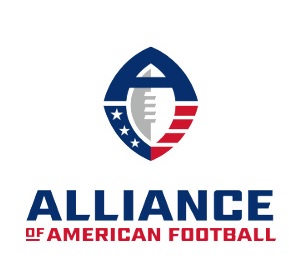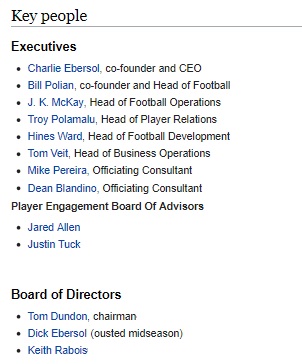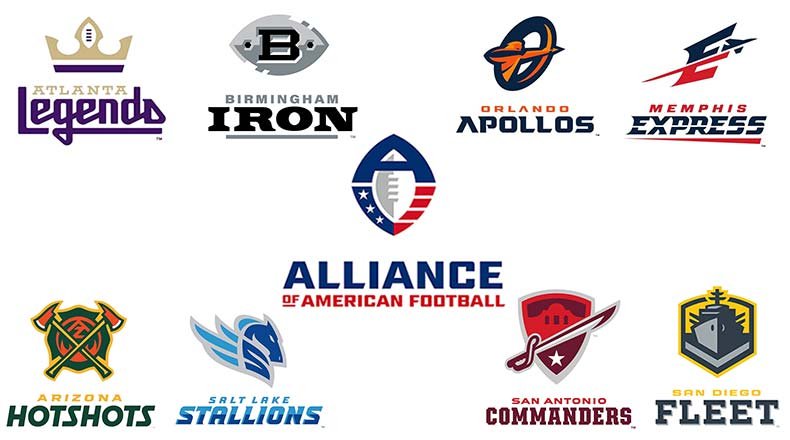The original logo of the AAF:

Below is a list of the key people that were involved with the AAF operations:

History of the AAF
Filmmaker Charlie Ebersol was inspired to create the AAF in late 2016 after producing the documentary This Was the XFL for ESPN Films' 30 for 30 series; upon researching and examining the history of the XFL, he came to the conclusion that the concept was viable but that the finished product was both poorly executed and, from an on-field standpoint, bad football. He began developing the AAF in February 2017, about the same time that word had come out about XFL co-founder Vince McMahon possibly reviving the old XFL brand. Exhibits in a lawsuit filed by Robert Vanech, who claimed to have co-founded the AAF, state that Ebersol had originally approached McMahon about relaunching the XFL but was unable to come to an agreement, as Ebersol wanted control of the XFL brand and was willing to pay $50 million for the trademark, which McMahon was unwilling to sell.
The AAF was announced on March 20, 2018. Ebersol sought to focus on creating a solid football product in the hopes that it would attract fans. He hired a team of experienced football players, coaches and executives to prepare the league for launch. The AAF was overseen by former NFL general manager Bill Polian, former Pittsburgh Steelers safety Troy Polamalu, and executive J. K. McKay. Advisers also include former Steelers receiver Hines Ward, former New York Giants and Oakland Raiders defensive end Justin Tuck, retired referee and current Fox NFL rules analyst Mike Pereira, and Ebersol's father, retired NBC Sports executive (and co-founder of the original XFL) Dick Ebersol.
Ebersol attended the first XFL game in Las Vegas in 2001, and remembered how disappointed his father was by the poor quality of play. To ensure professional-level football at launch, the AAF set out to hire coaches with professional football coaching and championship experience. On April 7, 2018, the first team, Orlando, was announced with its coach Steve Spurrier. By June 2018, the league had announced its eight inaugural teams and their cities.[10]
On July 30, 2018, the Alliance announced the league had signed 100 players. In August 2018, the league held the Alliance Scouting Combine at three locations and four dates: August 4, 2018 in Los Angeles, California; August 18 in Houston, Texas; and August 25–26 in Atlanta, Georgia. By August 24, 2018, 205 players were signed. These dates provided an opportunity for players cut at the NFL roster deadline, and each player signed a non-guaranteed three-year contract worth a total of $250,000 ($70,000 in 2019; $80,000 in 2020; $100,000 in 2021), with performance-based and fan-interaction incentives allowing for players to earn more.
In July 2018, Starter, through G-III Sports, which manufactured NFL jerseys and apparel in the 1980s and 1990s, was named the official on-field apparel and game-day uniform supplier for the AAF, marking a return for the brand to professional football after an almost 20 year absence. On September 20, the league announced four eastern inaugural franchises' names and logos. The four western teams' logos and names were revealed five days later.
The logos and team names are below in the picture:

Rules of play in AAF
Charlie Ebersol deliberately avoided making radical changes to the rules of the game so as to make it recognizable to the U.S. public. He stated that he used the average length of a feature film, slightly over two hours, as the basis for a typical fan's attention span.
- Teams had 52 players on each roster, with some selected by a territorial draft. The territory assigned to a team consisted of at least five colleges plus designated professional teams, one Canadian Football League, and four NFL teams (players from colleges outside the AAF footprint being allocated based on their most recent professional team). Only one quarterback could be taken from their region.
- For the inaugural season, a quarterbacks-only "Protect or Pick" draft was conducted in November 2018 in which teams could retain their allocated quarterback or select an unprotected quarterback from another team.
- Telecasts featured no television timeouts and 60 percent fewer "full-screen commercials," with the league aiming for an approximate real-time game length of 150 minutes, down from just over 180 in the NFL. In turn, the AAF aimed to charge more money for the remaining commercial slots, also alluding to product placement opportunities that do not interrupt the game telecast.
- There were no extra point kicks; teams must attempt two-point conversions after a touchdown.
- Defenses were forbidden from advancing ("rushing") more than five players on or across the line of scrimmage, and no defensive player can cross the line of scrimmage from more than two yards outside the offensive tackles. The "illegal defense" penalty for violating these rules is a 15-yard penalty.
- There were no kickoffs; possession at the start of each half, and after touchdowns and field goals, begins on a team's own 25-yard line, in line with the NFL touchbacks. After a safety, the scoring team receives possession at their own 35-yard line.
- In lieu of an onside kick, a team could keep possession of the ball by attempting an "onside conversion", a scrimmage play from their own 28-yard line and gaining at least 12 yards (essentially, a fourth-and-12 play). A team was not allowed to attempt such a play after a field goal or touchdown unless it was trailing by 17 or more points, or during the final two minutes of the first half, or during the final five minutes of the second half. The onside conversion play was also available after any safety, played from the 18-yard line.
- The play clock ran only 35 seconds, five seconds shorter than in the NFL, but still longer than the CFL's 20 seconds, timed from the spotting of the football. (The league originally proposed a 30-second play clock, but Ebersol concluded it would negatively impact the quality of play.)
- Players could not throw the football into the stands or hand it off to a spectator following a touchdown. While other leagues (particularly the NCAA) have similar rules in place using rationale based on sportsmanship, the primary motivation for the AAF rule appears to be economic as its footballs (manufactured by Wilson Sporting Goods and marked with distinctive red, blue, and white stripes) contain expensive tracking technology. The penalty for such behavior is unsportsmanlike conduct, a 15-yard penalty, and if it is determined to be deliberate, a fine can be assessed to the offending player. Other touchdown celebrations are generally tolerated.
- Trent Richardson of the Birmingham Iron was penalized during the first week of AAF play, when a ball he spiked after scoring a touchdown bounced into the stands. AAF officials later determined that Richardson's actions were accidental and did not assess the fine, also apologizing for the penalty.
- There were no automatic instant replay reviews of scoring plays or turnovers as there are in the NFL. Each team was given two coach's challenges, which they could use at any time outside the two-minute warning, and receive a third if both challenges are successful. After the two-minute warning in each half and during overtime, the replay booth had sole authority to call for a replay review.
- Outside organizations handle head-safety protocols.
- In the event of a tie at the end of regulation, a single overtime period would be played, under the high school football rules of the "Kansas Playoff." Each team would begin on their opponent's 10-yard line and be given one possession (four downs) to score, with no field goals Had a score remained tied after each team was given their possession, the game would end in a tie. Both teams would be given one timeout per overtime possession. The coin toss winner could choose to possess first or defer. Had the AAF reached the postseason, accounts differed on what system would be used; early reports had repeated rounds of the Kansas Playoff played until a winner was determined, but later reports stated that the AAF would use sudden death (golden point), which had been abolished at all other levels of football by the time of the AAF's debut.
- Playoffs would have consisted of four teams, the top two teams from each conference.
- Officiating crews had eight members on the field, similar to NCAA Division I football, instead of the standard seven-official system used in the NFL and CFL (the eighth officiating member was the center judge). AAF officiating also had a ninth member, called a sky judge, an off-the-field official who reviews every play using technology like a booth review. The sky judge could call or take away penalties missed or made by the field officials.